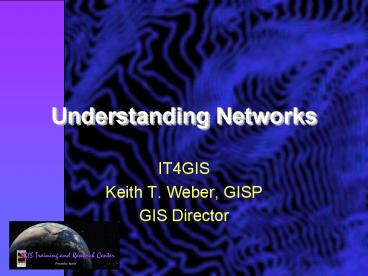Understanding Networks - PowerPoint PPT Presentation
1 / 28
Title: Understanding Networks
1
Understanding Networks
- IT4GIS
- Keith T. Weber, GISP
- GIS Director
2
Why is Networking Important?
- GIS has always been cursed with the need to use
large files - GISers have always acted as a community
- Sharing is normal
3
How to Facilitate Sharing
- Floppy disks
- Bernouli disks
- Zip disks
- Jazz disks
4
In the beginning
- There were floppy disks
- And the Sneaker Net
5
Then along came
- Networks
- Cabling that allowed computers to connect to one
another - Token ring
- Developed by IBM
- Using coaxial cable
- And then
6
Ethernet
- Developed by Xerox
- Uses Star-topology
- And twisted pair cabling
7
Cabling
- Twisted pair cabling can be either unshielded
(UTP) or, - Shielded
- IT4GIS will focus on UTP
8
Capabilities
- Ethernet is described by its data rate and range
- For instance
- 10Base-2
- 10 (data rate, 10Mb/s)
- Base (base band)
- 2 (range, 200 meter runs)
9
Ethernet and GIS
- Data rates are 10, 100, and 1000
- 10 10 Mb/s
- Uses Cat 3 cabling
- 100 100 Mb/s, called Fast Ethernet
- Uses Cat 5
- 1000 1 Gb/s
- Uses Cat 5E
10
Gigabit Ethernet
- Data rates of 1, 10, or 100 Gb/s
- 1 Gb/s is supported by Cat5E cabling
- A good GIS workstation option
- Gigabit to the desktop
- 10 Gb/s requires copper cabling
- 100 Gb/s requires fiber optic cabling
11
Ethernet and GIS
- Ranges are 2, 5, T
- 2 200 m
- 5 500 m
- T well
- It stands for twisted pair. Cable testing tools
will determine how long a run can be and still
pass characteristics test (based on standards) - Runs as long as 150 m can be used.
12
Whats Next
- Wi-Fi (wireless-fidelity)
- Developed by Cisco, 3Com, Lucent, Nokia, and
others - Specs are described under the IEEE 802.11 group.
13
Advantages and Limitations of Wi-Fi for GIS
- Brain-storm
- Advantages
- No cabling
- Fairly inexpensive
- Disadvantages
- Security
- Traffic can congest at the 2.4 Ghz frequency
- Size of transmission (bandwidth)
14
A Look at 802.11
- B6.5 Mb/s (1999)
- G24.0 Mb/s (2003)
- N200 Mb/s (2007)
- Operates at the 2.4Ghz or 5Ghz freq.
- How do these compare for GIS???
15
Getting Data from Here to There
- Recap
- We know something about the history of networks
- We know about current Ethernet, Fast Ethernet,
and Gigabit Ethernet technologies - We know about Wi-Fi capabilities
- These are the Data Link and Physical Layers,
referred to as the Network Access Layer. - But, how does the GIS Data get from here to there
on the networkregardless of the type of network
16
Good Question!
- Packets and Protocols
- TCP-IP is most common
4. Application
3. Transport
2. InterNetworking
1. Network Access
1. Network Access
17
InterNetworking Layer
- Internet Protocol addressing
- Currently IP v4 is in use. This is a 32bit
system allowing 4.2B addresses. - IP v 6 is new, 128-bit addressing. Allowing 2128
addresses.
18
Transport Layer
- TCP
- Transmission Control Protocol
- Phases of operation
- Establish connection
- Transfer data
- Terminate connection
19
Application Layer
- You know these well
- HTTP
- SMTP
- FTP
20
Wheres the Network
- Recap
- We have now learned how the data moves in packets
from our computer through the layers of the
TCP-IP model onto the Internet - But, wheres the Internet
21
The Internet Highway
- From your workstation
- LAN
- Backbone at the Point of Presence
- AKAISP
- AKAPoP
22
Various Backbones
- Reduncy through
- ARPANet
- NSFNet
- Abilene (I2)
- National LambaRail
23
We could go on forever
- For IT4GIS, we have gone far enough
- But todays discussion of networks would not be
complete without mention of the second-generation
Internet, web2.0
24
Web2
- Is not Internet2
- Is not hardware
- Is not software
- Isa whole new way that the Internet is used.
- Participatory
- Users are now prosumers instead of consumers
25
Participatory Web
- Examples
- Wikipedia
- MySpace
- Innocentive
- What will this mean
- for GIS?
26
GIS and the Web
27
Key Concepts
- Understand how data moves over a network
- Understand the importance of data rate for GIS
applications. - Watch the potential of wireless for GIS
- Understand the roles of the various layers within
the TCP-IP model - Understand new terminology like PoP and GigaPoP
- Contemplate the affect of Web2
28
Questions

